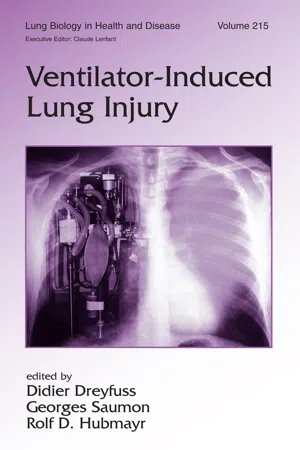
eBook - PDF
Ventilator-Induced Lung Injury
This is a test
- 776 pages
- English
- PDF
- Available on iOS & Android
eBook - PDF
Ventilator-Induced Lung Injury
Book details
Table of contents
Citations
About This Book
This reference surveys current best practices in the prevention and management of ventilator-induced lung injury (VILI) and spans the many pathways and mechanisms of VILI including cell injury and repair, the modulation of alveolar-capillary barrier properties, and lung and systemic inflammatory consequences of injurous mechanical ventilation. Cons
Frequently asked questions
At the moment all of our mobile-responsive ePub books are available to download via the app. Most of our PDFs are also available to download and we're working on making the final remaining ones downloadable now. Learn more here.
Both plans give you full access to the library and all of Perlego’s features. The only differences are the price and subscription period: With the annual plan you’ll save around 30% compared to 12 months on the monthly plan.
We are an online textbook subscription service, where you can get access to an entire online library for less than the price of a single book per month. With over 1 million books across 1000+ topics, we’ve got you covered! Learn more here.
Look out for the read-aloud symbol on your next book to see if you can listen to it. The read-aloud tool reads text aloud for you, highlighting the text as it is being read. You can pause it, speed it up and slow it down. Learn more here.
Yes, you can access Ventilator-Induced Lung Injury by Didier Dreyfuss, Georges Saumon, Rolf Hubmayr, Didier Dreyfuss, Georges Saumon, Rolf Hubmayr in PDF and/or ePUB format, as well as other popular books in Medicine & Pulmonary & Thoracic Medicine. We have over one million books available in our catalogue for you to explore.
Information
Table of contents
- Front Cover
- Introduction
- Preface
- Contributors
- Contents
- 1. Shear and Pressure-Induced Mechanotransduction
- 2. Pulmonary Micromechanics of Injured Lungs
- 3. Response of Cellular Plasma Membrane to Mechanical Stress
- 4. Acute Passive and Active Changes in Microvascular Permeability During Lung Distention
- 5. Hemodynamic Interactions During Ventilator-Induced Lung Injury
- 6. Lung Mechanics and Pathological Features During Ventilation-Induced Lung Injury
- 7. The Significance of Air–Liquid Interfacial Stresses on Low-Volume Ventilator-Induced Lung Injurya
- 8. Cellular and Molecular Basis for Ventilator-Induced Lung Injury
- 9. The Role of Cytokines During the Pathogenesis of Ventilator-Associated and Ventilator-Induced Lung Injury
- 10. Systemic Effects of Mechanical Ventilation
- 11. Alveolar Fluid Reabsorption During VILI
- 12. Interaction of VILI with Previous Lung Alterations
- 13. Biological Markers of Ventilator-Induced Lung Injury
- 14. Modulation of Lung Injury by Hypercapnia
- 15. Alveolar Epithelial Function in Ventilator-Injured Lungs
- 16. Genomic Insights into Ventilator-Induced Lung Injury
- 17. Lung Imaging of Ventilator-Associated Injury
- 18. Imaging Ventilator-Induced Lung Injury: Present and Future Possibilities
- 19. Modulation of the Cytokine Network by Lung-Protective Mechanical Ventilation Strategies
- 20. Role of Tidal Volume and PEEP in the Reduction of VILI
- 21. A Critical Review of RCTs of Tidal Volume Reduction in Patients with ARDS and Their Impact on Practice
- 22. The Importance of Protocol-Directed Patient Management for Research on Lung-Protective Ventilation
- 23. Crossing the Quality Chasm in Critical Care: Changing Ventilator Management in Patients with ALI
- 24. How to Design Clinical Studies for Preventing Ventilator-Induced Lung Injury
- 25. Perfluorocarbons and Acute Lung Injury
- 26. Prospects for Reduction of Ventilator-Induced Lung Injury with Surfactant
- 27. Rationale for High-Frequency Oscillatory Ventilation in Acute Lung Injury
- 28. Gene Therapy for Ventilator-Induced Lung Injury
- Index